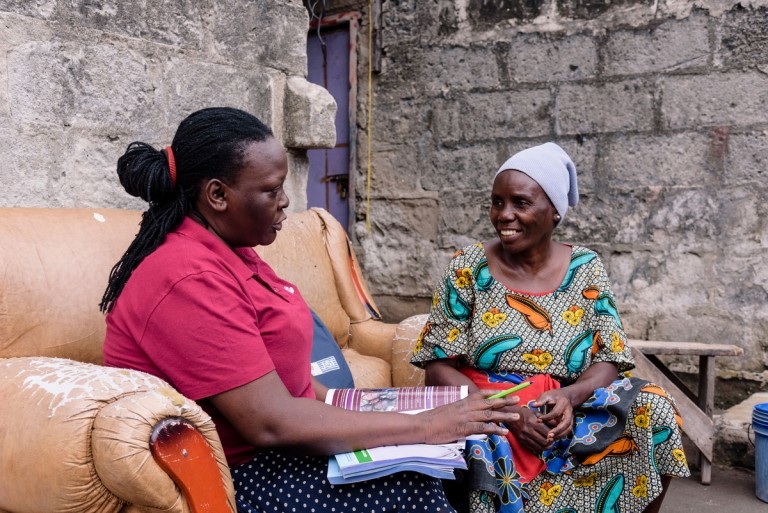Blog
Ending the HIV epidemic: Equitable access, everyone’s voice

Every December 1, we mark World AIDS Day around the world. The internationally recognized day is a time for reflection and recognizing how far we have come in the fight against HIV and AIDS. It is also an opportunity to bring attention to where we stand in that fight, spread awareness and knowledge of HIV and renew commitments to end AIDS globally in our lifetimes.
This year’s theme, Ending the HIV Epidemic: Equitable Access, Everyone’s Voice, spotlights two long-standing issues that those of us working in the HIV field have been aware of for many years, which have been made more prominent by the Covid-19 pandemic: the lack of health equity and limited inclusion of marginalized people in the global response.
Understanding who we’re not reaching
The call to end AIDS is a call to social justice. Transmission of infectious diseases, like HIV and Covid-19, is driven by disparities in health access that are rooted in social and economic inequalities. Communities that are stigmatized, marginalized and discriminated against have higher rates of HIV transmission globally. We will not be able to end AIDS without addressing the social, economic, cultural and gender inequalities that put these populations more at risk for HIV infection.
The call to end AIDS is a call to social justice.
To do this, we must better understand who we are not reaching, particularly those who are at highest risk or marginalized and often prefer not to engage with traditional HIV programs and formal health care systems. Efforts to reach these “last mile” populations must recognize and respectfully engage them as partners and stakeholders in the HIV response. This requires that we build an understanding of the much more nuanced needs of the hardest to reach populations and expand options for facilitating their access to HIV prevention, testing and treatment services.
A client-centered approach
When we're designing HIV programs, often we are looking at whole communities or populations, but we must go deeper and understand who exactly we are trying to reach. We need to reach the people who are most vulnerable to HIV, understand who they are, and ask about their concerns, barriers and how they would like to receive care and support. Most importantly, we need to work side-by-side with them to deliver services that meet them where they are.
This starts with identifying and understanding various population subgroups. For example, orphans and vulnerable children are not one general group. Within orphans and vulnerable children, there are subgroups with varying needs and vulnerabilities, such as children of female sex workers, children living on the streets, and children who live in a household where they are exposed to violence, among others. Beyond understanding their HIV needs, we also need to understand and address their non-HIV needs, such as helping them access support for nutrition, staying in school, violence prevention, and improved livelihood, which are just as important for reaching, engaging and retaining them in HIV prevention and treatment.
The emphasis on delivering HIV services around the needs of clients has been a positive development in the global HIV response. Further scale-up of client-centered approaches will be critical for ending AIDS and addressing the inequities that exist in health and HIV care.
Nothing for them without them
From the beginning of the AIDS pandemic, people living with HIV and communities affected by HIV and AIDS have made it clear that there is nothing for them without them. People who are responsible for HIV programs must include clients at all stages of programming, from design to program implementation and monitoring to feedback. This allows us to continuously improve on the programs, services and support that we provide, ensuring that we meet clients’ real needs and that services are appealing to them.
One example of how Pact has done this is in Eswatini, where Pact implements the USAID/PEPFAR DREAMS program, which focuses on reaching adolescent girls and young women. Recently, the program organized a forum that brought together adolescent girls and young women with DREAMS implementers and policymakers from the Ministry of Health and other government agencies in Eswatini. The adolescent girls and young women voiced their concerns, challenges and needs to all project stakeholders. They spoke about what is working for them through the current DREAMS program and what could be improved. Their feedback has informed concrete actions for promoting HIV prevention services among youth in an appealing and exciting way in community and health facility settings. This is only one example of how we are working with clients to better understand them. From this experience and others like it, we see that when we intentionally and directly engage with HIV affected communities and provide a space for them to share their voice, we develop better and more innovative solutions to meet their unique needs. The end of AIDS is within our grasp. Addressing inequalities and exclusion of people with HIV and those at highest risk in the global response could be the difference-makers to achieving this reality. Putting those who we intend to reach at the center of our approach and ensuring their voices are heard is the only way forward.